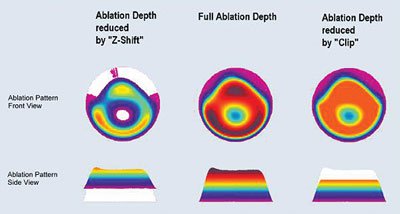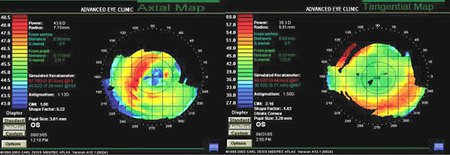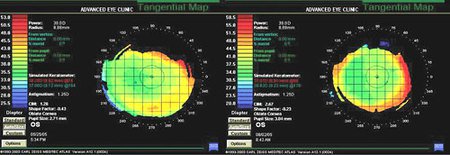Topography-guided retreatment achieves good results with latest software advances
The new software for the MEL 80 is the successor of TOSCA and WASCA.
The CRS-Master software, together with the MEL 80 excimer laser system from Carl Zeiss Meditec, can improve visual quality and eliminate night vision problems in patients with suboptimal results from refractive surgery, according to the preliminary results of a multicenter trial.
“At this stage of our experience as refractive surgeons, we still have to deal with the imperfect treatment outcomes of the previous generation of excimer lasers. Topography-linked retreatment is the way to do it, but the systems that we have been using so far had fairly disappointing results. The CRS-Master opens up exciting new possibilities for corneal repair, and the satisfaction of the patients we have treated so far demonstrates that we have finally achieved what we were looking for,” said Chris P. Lohmann, MD, of Munich Technical University, Germany.
Results with the new systems seem to be of significantly better quality. “They are very reproducible, reliable and extremely accurate. Thanks to this new technology, we have finally achieved the standard of care that we want for our patients,” he said.
 Example of the effects of Z-Shift and Z-Clip. The white areas are those in which no tissue is removed. Images: Lohmann CP |
Extended features
Reoperation cases are primarily related to decentration, small optical zones, surface irregularities and the inadequate, mainly spherical corneal profiles that were used in the past, Dr. Lohmann said.
“We might have obtained a good refraction and a perfect visual acuity, but we have at the same time generated visual problems like glare, halos, coma and spherical aberration,” he said.
Advances in the theory and practice of refractive surgery, in combination with the latest available technologies of excimer lasers, have reduced the occurrence of these problems, Dr. Lohmann said. The same advances have also produced new instruments for repairing the unwanted effects of previous surgeries.
The CRS-Master is the successor of TOSCA for the MEL 80 laser, and it has extended features, Dr. Lohmann said. It is based on a new algorithm and has undergone full automatic optimization for maximum user comfort and treatment reliability, he said.
The first clinical trials, involving four European centers (Antwerp, Munich, Nuremberg and London), are ongoing, and the system will soon be available on the market.
Via the CRS-Master software, the Atlas 995 corneal topographer is linked to the MEL 80. A wavefront-link (the successor of WASCA) can also be activated for integrated treatment planning. This new wavefront-link has improved features for data analysis, produces clear, high-resolution wavefront maps and performs precise positioning of the wavefront correction on the eye. It can be used alone or in conjunction with topography.
Dr. Lohmann said he prefers topography-guided retreatments because, he said, “if something wrong has been done to the cornea, then it should be retreated at the corneal level rather than on the whole wavefront measurement.”
An internal network connection with the Atlas database allows the selection of individual patient data or patient groups. The data are processed by the CRS-Master and converted into the ablation profile for the laser.
“The automatic selection of the optical zone is centered on the pupil but takes into account individual variables such as the corneal apex and the visual axis. Hyperopic patients, for instance, are very difficult to treat because of the angle kappa. The CRS-Master calculates the center shift for angle kappa compensation and automatically transfers these data to the ablation profile, thus minimizing the induction of coma,” Dr. Lohmann said.
Once all the data have been introduced, a simulation map shows the target topography. The mouse pointer indicates the local ablation depth value, which can be optimized using the software.
“If you do smoothing treatments or treat irregular flap complications, this option is important because the computer shows where you are taking off too much or too little and automatically sets the values for different quantities of tissue ablation in different areas,” Dr. Lohmann explained.
Other user-friendly features include an ergonomic workstation design, a USB memory stick transfer option and the use of a laptop rather than a fixed computer.
|
|
|
|
Retreatment cases
The topography-guided treatment effectively addresses LASIK flap-related complications, Dr. Lohmann said. In one patient with incomplete flap and consequent diplopia and dry eye, the cornea was smoothed by a topography-guided surface treatment.
“This eye that was –7.25 –2.00 × 80° became almost emmetropic after the treatment, gained two visual acuity lines and was free of night vision problems. This was obtained by just doing the topography-guided ablation, with no refraction included. The cornea is still slightly irregular, and after healing the patient might have another treatment, but for the time being she’s very happy with these results,” Dr. Lohmann said.
Corneal irregularities, he said, should always be treated as a first step without including refraction.
“The aim should not be primarily that of treating the refractive error, but that of getting a nice corneal surface,” he said.
For Your Information:
- Chris P. Lohmann, MD, can be reached at Augenklinik rechts der Isar, Technische Universität, Ismaninger Str. 22, 81675 München, Germany; +49-89-4140-2320; e-mail: chrislohmanneye@aol.com. Ocular Surgery News was unable to confirm whether Dr. Lohmann has a direct financial interest in the products mentioned in this article or if he is a paid consultant for any companies mentioned.
- Carl Zeiss Meditec, maker of the CRS-Master software and the MEL 80, can be reached at Goeschwitzer Str. 51-52, 07745 Jena, Germany; +49-36-41-2-20-0; Web site: www.meditec.zeiss.com.
- Michela Cimberle is an OSN Correspondent based in Treviso, Italy, who covers all aspects of ophthalmology. She focuses geographically on Europe.


